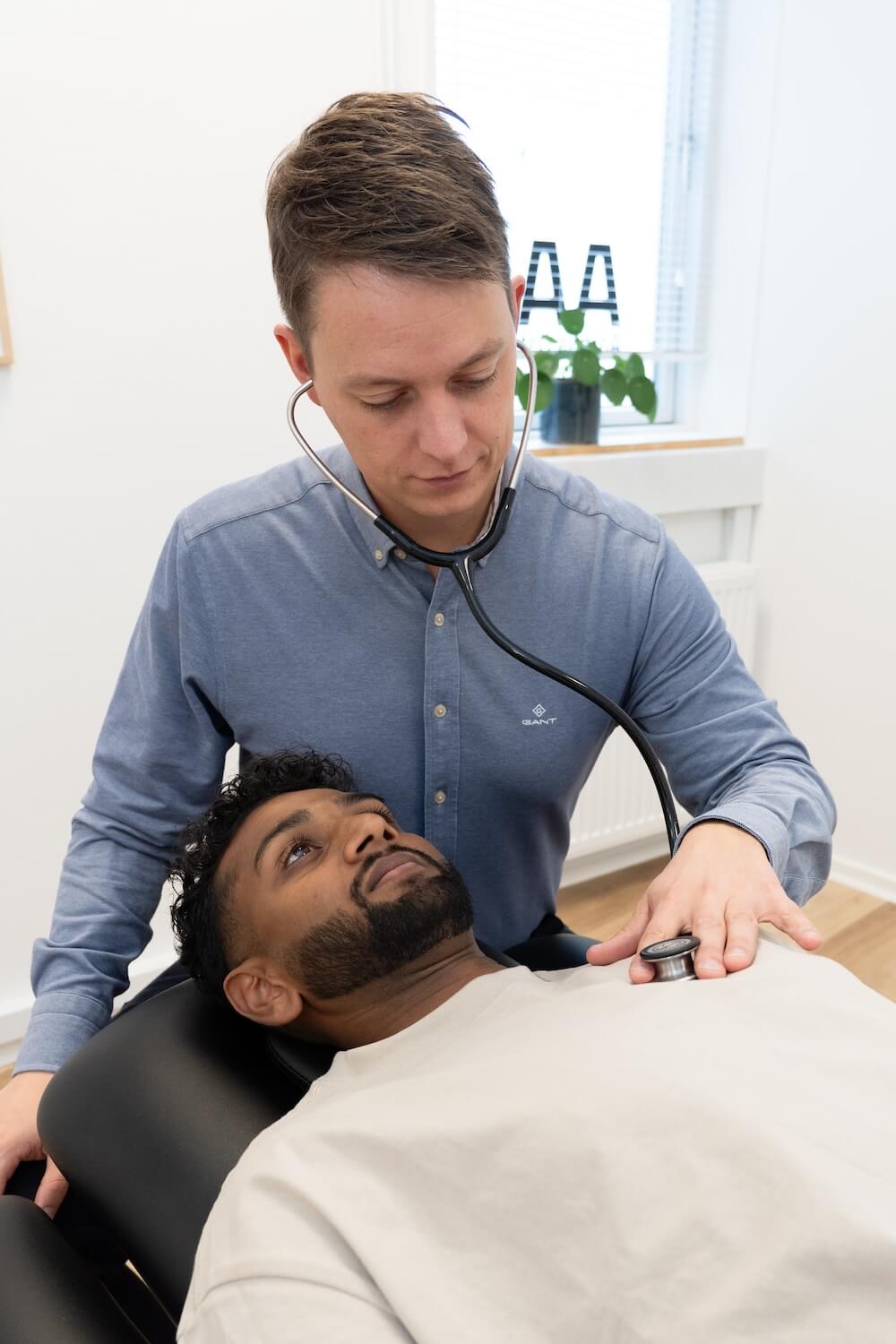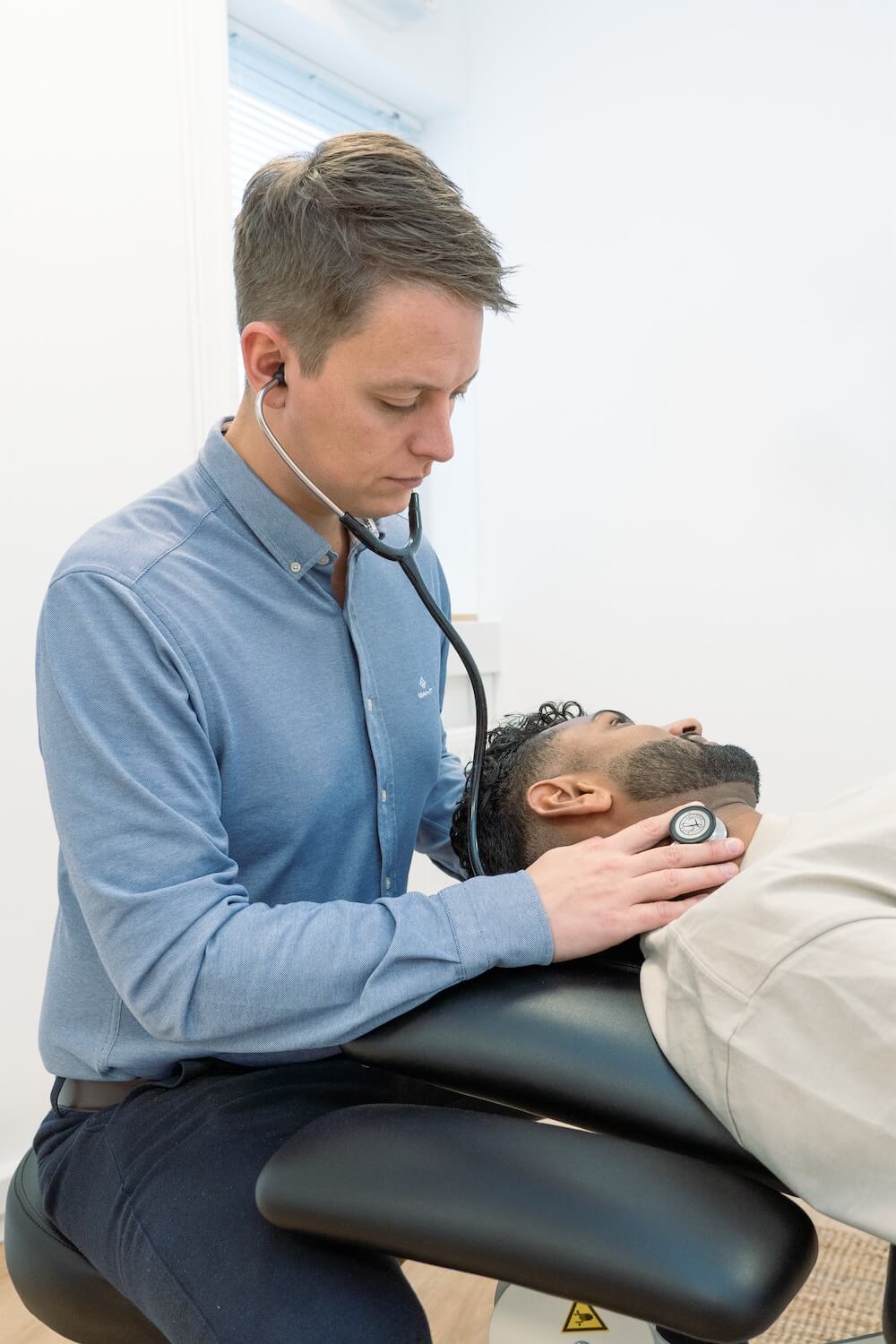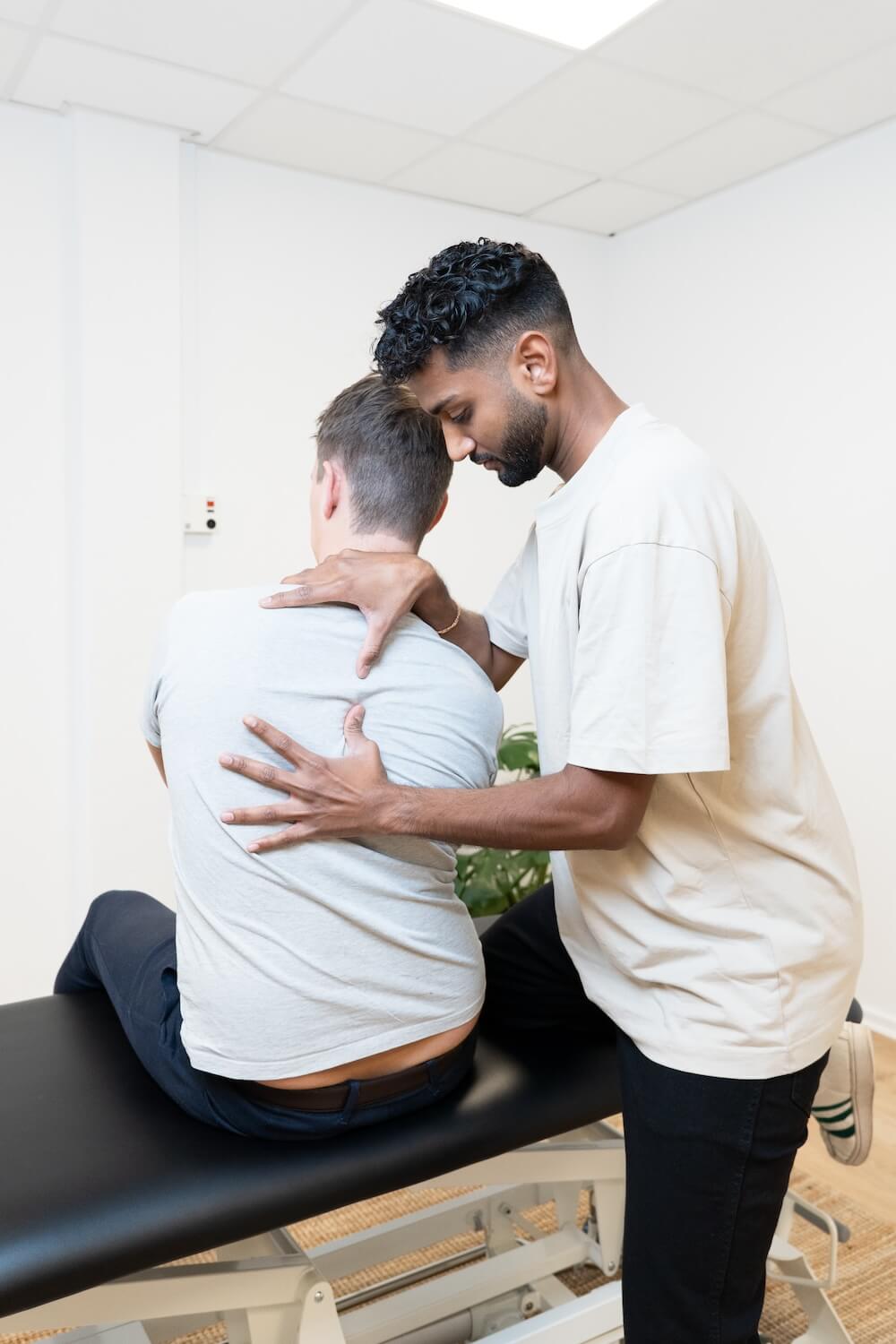We help with problems caused by
Eye inflammation
Learn more about eye inflammation and its treatment
What is eye inflammation?
Conjunctivitis, also known as pink eye, is a common eye condition that involves inflammation of the mucous membrane. The conjunctiva is the thin, transparent membrane that covers the white part of the eye and the inside of the eyelids. The conjunctiva protects the eye from dust, dirt, and microorganisms that can cause infection. The mucous membrane produces mucus and tears, which keep the eye moist and help spread the tear film evenly over the surface of the eye, as well as facilitating the movement of the eyelids over the eye. The mucous membrane also contains immune cells that help fight infection and protect the eye from damage. Conjunctivitis often starts in one eye and spreads quickly to the other, especially with viral infections, due to its high contagiousness.
Jump to section [Vis]
Causes of eye inflammation
Infections
Bacterial eye inflammation: Can be caused by various bacteria, but most often it is the bacterium Staphylococcus aureus. Bacterial eye inflammation is often characterized by yellow or greenish pus and sticky eyes, especially in the morning, as well as red eyes and eye irritation.
Viral eye inflammation: Often caused by viruses, which also cause the common cold. It can cause watery discharge from the eyes and is highly contagious. It is often characterized by watery eyes, red eyes, and swollen eyelids. It can cause eye discomfort and sensitivity to light.
Allergies
Allergic conjunctivitis can develop in cases of allergies, such as pollen, dust or animal hair. The eye’s response to the allergy can manifest itself in the mucous membrane or eyelid as inflammation. Allergic conjunctivitis often causes itchy, red and watery eyes. Eye inflammation caused by allergies is not contagious.
Irritants
Substances such as smoke, chlorine in swimming pools, or chemicals can cause irritated and red eyes that water.
Chronic eye inflammation
Chronic eye inflammation lasts for a long time (over four weeks) and can be caused by several different factors. This type of eye inflammation often occurs in connection with conditions in or around the eye area that irritate the mucous membrane. For example, inflammatory conditions of the eyelids can be a contributing cause.

Symptoms of eye inflammation
The symptoms of eye inflammation can vary depending on the cause, but common symptoms include:
-
- Red eyes
- Eye discharge (clear, yellow, or greenish depending on the cause)
- Itching or irritation
- Excessive tearing
- Swollen eyelids
- A feeling of gravel or sand in the eye
Medical treatment of eye inflammation
Treatment depends on the cause of the inflammation:
Bacterial eye inflammation
Viral eye inflammation
This type of inflammation usually goes away on its own within five to ten days and often occurs with a cold. Treatment is primarily aimed at relieving symptoms, for example by using saline solution or cold compresses.
Allergic eye inflammation
Allergic eye inflammation can be treated with antihistamine eye drops if the allergy is primarily localized to the eyes, or oral antihistamines to reduce the allergic reactions.
Irritants
Removing the source of irritation and rinsing the eyes with sterile water or saline may help relieve symptoms.
Association between narrow tear ducts and eye inflammation
The tear duct is part of the tear drainage system, which helps keep the eye healthy and free from irritation. The system consists of tear glands that produce tears that lubricate and protect the surface of the eye. The tears drain through small openings at the edge of the eyelids and into the nose. This drainage prevents tears from running down the cheeks and helps keep the eye clean.
Effective drainage of tears prevents the build-up of bacteria that can cause infection. If the tear ducts become blocked, the tears cannot drain properly, which can lead to tear stagnation and create a moist environment where bacteria thrive. In severe cases, repeated episodes of conjunctivitis can lead to narrowing of the tear ducts due to scar tissue formation, which can worsen the blockage.
Causes of narrow tear ducts
Narrow tear ducts can be congenital, and in most cases the problem will resolve itself within the first year of life. However, treatment may sometimes be necessary.
As we age, the tissues surrounding the tear ducts can become thinner and more fragile, which can lead to blockage. Chronic inflammation, such as sinusitis, allergic rhinitis, or conjunctivitis, can cause inflammation that leads to narrowing of the tear ducts. Repeated eye or nasal infections can lead to scarring or swelling, which can also cause blockage. In addition, injuries to the nose, eyelids, or surrounding areas such as the forehead, jaw, and cheekbones—either from trauma or surgery—can result in tear duct blockage.
Eye Muscles Can Affect Tear Duct and Eye Inflammation
The eye is surrounded by six muscles that control its movements up, down, sideways, and when turning. These extraocular muscles can become tense due to factors such as incorrect prescription glasses, lack of glasses, stress, or prolonged computer work. Tension in the eye muscles can increase pressure on surrounding tissues and structures, including the tear ducts, thereby obstructing the drainage of tears to the nose.
The eye muscles attach to various bones in the eye socket. Tension can affect the bones of the skull and their mobility, which can put pressure on the tear ducts. Blows or trauma to the head can also displace or reduce the mobility of the bones of the skull, which can strain both the tear ducts and the eye muscles. The eye muscles are controlled by the cranial nerves oculomotor (CNIII), trochlear (CNIV) and abducens (CNVI), which can also become trapped between the bones in the eye socket.
When the tear ducts are compressed due to tense muscles and the position of the skull, it can lead to excessive tearing, recurrent eye inflammation, and pain and discomfort around the eyes.
Nerve Innervation of the Mucous Membrane of the Eye
The mucous membrane of the eye is innervated by nerves that send and receive information between the brain and the eye. Sensory nerves detect stimuli such as irritation and injury and trigger reflexes such as blinking and squeezing the eyelids to protect the eye, especially during an eye infection. The trigeminal nerve (CNV), especially its first branch, is the primary sensory nerve that innervates the mucous membrane.
Autonomic nerve innervation controls unconscious body functions and is divided into sympathetic and parasympathetic innervation, both of which can affect mucosal inflammation.
The sympathetic division activates the body’s “fight or flight” response, regulating the diameter of blood vessels and controlling blood flow, which affects blood supply to the mucous membrane. This is important in eye inflammation, as the blood carries immune cells and nutrients to the affected area with bacteria or other irritants. The immune cells are activated and begin to phagocytose (eat) microorganisms, cell debris and foreign particles, which can cause redness and swelling. Once the infection is under control, the inflammation begins to subside and the eye inflammation improves.
The parasympathetic innervation, which comes from a branch of the facial nerve (CNVII), activates the “rest and digest” response, which controls tear production in the eye. This keeps the mucous membrane moist and cleans the eye by stimulating the lacrimal gland.

Eye inflammation in babies
About 6% of all infants have blocked tear ducts, which may be due to delayed tear duct development. This can lead to increased tearing and an increased risk of pus formation in the eye. While it is normal to have some pus in the eye without redness or irritation, poor drainage of tears can lead to eye inflammation. Blocked tear ducts will often get better on their own during the first year of life.
The most common eye infection in babies and children is often caused by a viral infection associated with a cold and does not require medical treatment. The infection usually clears up on its own after 1-2 weeks. Symptoms often include watery tears, some pus in the morning, itching and irritation, and redness of the entire eye. The eye infection is highly contagious and often spreads to both eyes.
If it is a bacterial infection, the eye will be red, sensitive to light and filled with pus, often completely glued together and possibly swollen. In such cases, it is important to contact a doctor for further examination and possible treatment with antibiotics, if necessary.
Tension in the skull and neck after birth can also affect the function of the tear ducts. During birth, pressure and movement can lead to tension in the bones and tissues of the skull, which can affect the ability of the tear ducts to drain properly. Osteopathic treatment can in many cases help relieve this tension and improve the function of the tear ducts.
Tips for managing eye inflammation and blocked tear ducts
- Clean the eyes with a cotton pad with saline (0.9%) or boiled water. Start cleaning from the corner of the eye outwards. Change the pad before cleaning the next eye.
- Hygiene is very important – wash toys, towels and other things that the child comes into contact with, and ensure good hand hygiene.
- Gently massage the tear ducts at the inner corner of the eye to stimulate drainage of the tears.
- Babies and children also benefit greatly from osteopathic treatment to improve narrow tear ducts and any swelling in the skull and neck after birth.
What can an osteopath treat?

Cranio-sacral therapy
Using craniosacral therapy, gentle manipulation techniques can improve the mobility of the bones of the skull, which can relieve pressure on the tear ducts and improve the drainage of tears. This also has a positive effect on tense muscles around the eye and nerves that may be pinched. Improved mobility can help relieve pressure and irritation, which are important factors for eye inflammation.
Fascia and muscle mobilization:
The entire body is covered in fascia (connective tissue) that surrounds muscles and organs. Treatment of the fascia and muscles around the eyes and nose can improve tissue elasticity and reduce compression of the tear ducts. Tension in the eye muscles can be relieved with gentle techniques, which can help reduce irritation and inflammation.
Nerve and artery manipulation:
For a nerve to function optimally, it must be able to move freely to send and receive signals to the area it innervates. Gentle techniques can improve nerve mobility and function, which can relieve symptoms such as pain, muscle tension, and decreased function, for example in the eye muscles. Relieving tension around the arteries by gently treating the bones, muscles, or fascia of the skull can improve blood flow to the eye area. This can reduce infection and promote healing by increasing the supply of nutrients and immune cells.
It is also important to consider the balance of the whole body in relation to blood circulation. Tensions in the chest, around the heart or in the arteries can affect the smaller blood vessels in the head and face, and therefore these areas should also be included in the treatment.
Lymphatic drainage:
The lymphatic system, which consists of white blood cells, drains excess fluid and acts as the body’s defense against viruses, bacteria and infections. Lymphatic drainage around the eyes during eye inflammation can reduce swelling and fight infection in the mucous membrane by promoting the removal of fluid and waste products.
Prevention of eye inflammation
- Wash your hands often.
- Avoid direct eye contact to prevent the transmission of bacteria and viruses.
- Clean contact lenses often or wear glasses
- Healthy diet rich in vitamins and antioxidants that can strengthen the immune system and protect against eye infections.
- Regular eye examination to detect any eye problems in time
- Protection from irritants such as chemicals, smoke or dust that can cause irritation
- Wear sunglasses to protect your eyes from harmful UV rays.
- Do not share makeup to prevent the transfer of bacteria
- Change towels and head/duvet covers often
- Osteopathic treatment to keep the body in balance

Often related problems

Kissing disease

Diabetes mellitus

Eye inflammation

Padel injuries

Sedentary work

Nicotine and exercise

Shingles

